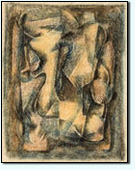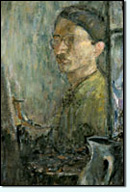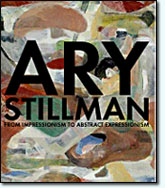Publications
Reminiscences > Ary Comes Back to the United States (1933-1941)
When Ary returned from Europe in 1933 he found that the money he had left behind for a friend to handle had been badly invested and there was nothing left of it. Ary was penniless and these were the days of the depression.

Ary painting
the World's Fair,
New York, 1939
I don't have a very clear picture of Ary in these days, for this was the period about which he talked the least. It must have been a sort of nightmare for him. Several friends bought paintings, and this helped him out, and he was taken up by the Midtown Gallery for a one-man show, which helped him get a footing in the New York art world. But when all the guests had left after the preview at Midtown he walked over to Central Park and sat there for hours, lost in melancholy. He missed his beloved Paris, and he didn't seem to fit into the art scene here, which was pretty much dominated by Americana — the Grant Wood, Thomas Benton style.
Ary was considered an expatriate, and there was hostility against him for that, and for his very French type of painting. Friends advised him to quit the Midtown for the Ehrich-Newhouse Gallery, and this alienated the devotees of the Midtown from him. He really was a babe in the woods when it came to adapting himself to the practical aspects of the art world of that time and it seems that he made one mistake after another in this respect.
A letter which Ary received in December 1939 from his very close friend Dr. Jacques Eskin paints a picture:
"...Bella and I were very glad to get your letter from Orizaba. Several times since I knew you it happened that after a time of the blues and despair you came back somehow renewed and refreshed. I am not looking for any pot boilers from you. I hope you will never have to descend to that. But if you should be inspired by the sharpness and strength of the Mexican scene (to judge from most of its painting) and combine it with the poetic expression which is yours it may break down the antipathy of those to whom you are still too French. Those who, though they have nothing particular to say, but say it in sharp heavy out-lines, seem to have it all their own way and are holding the critics' eye. It is not encouraging, this living in a hostile world, I must say. Not all immortals had to wait for Resurrection Day, and I hope you will not have to wait for that."
And many years later, when we were living in Paris in 1956, Ary's long time friend Nick Curcio wrote from Mexico City:
"How happy I was to get your Paris card! I've had nothing better for a hell of a long time. It makes me glow to have friends there, and such dear friends. I still remember, Ary, the radiant look on your face and the light in your eyes as you floated away in your chats about Paris. In consequence I never quite felt that you were satisfactorily settled in Manhattan. There was a yearning in your heart, an irresistible pull from abroad that kept you in spiritual turmoil. Disquieted and restless, your soul gave you no peace. You were not sufficiently adjusted to feel set in your new Manhattan surroundings. You couldn't or wouldn't adjust yourself to the movement then known as 'Americana.' You were faced with a crisis and you resolved it boldly. Your search and discovery of a new personal artistic expression at once linked you up with your European culture. Your struggle and pain and toil were rewarded. And then, like manna from heaven came another big thing in your life — your love for Frances. She strengthened you and your grip on things became firm. At last you were happy, and happy too because Frances soon learned to understand your work and intuitively felt the nature of the "
Following the vogue of Americana came the period of social conscious painting. Ary was very liberal in his ideas, he was terribly upset about the Spanish civil war and gladly worked with committees which were raising money to help the loyalists. But he was very much opposed to the Communist party, he had no intention of becoming a member or a fellow-traveler, and he clung to his ideal of painting as an aesthetic and emotional expression, not as the mouthpiece of political change or social message. This aroused much antagonism. At a meeting of the Artists' Union (or was it Artists' Congress?), of which he was a member, some women members shouted, "Kill him! Murder him!" when he got up to plead for an aesthetic basis of art. When he voiced ideas that the leftist leaders among the artists opposed, one of them threatened: "You'll be called up before the party!" But this didn't phase Ary, because he didn't belong to the party and didn't care what they thought about him. When Ary's painting "Times Square" was shown in exhibit, one of the artists praised it, but said that it would really have some meaning if he would paint, in the foreground, a striker being beaten by a policeman.
“He did have several years on the WPA Project, however, and was very conscientious about handing in good canvases.”
Despite all this, Ary managed to get on the WPA Project, although late in being accepted because he found out about it quite by accident, the "gang" not having advised him what was happening. He wasn't on the Project more than a couple of years, I believe, because when the order went out that only those who had no money at all and were on relief would be retained, Ary, who had finally salvaged a small sum from his real estate holdings in Europe, and had put it away as an emergency fund, would not represent himself as penniless. He did have several years on the Project, however, and was very conscientious about handing in good canvases. What happened to them I don't know, except that Colonel David Orr (I haven't been able to locate Col. Orr.) of Cedarhurst, Long Island, has one — "New York Night Scene — El Station." A school in Queens had another — "Little Harbor" — but when I inquired of the principal recently he didn't know what had happened to it. The American Archives of Art in Detroit sent the Foundation photographs of these two paintings, and three more: "Saturday at Coney," "Over the Roofs" and "Excavation". There was no record of what had been done with the paintings, other than the first two.

Coney Island (Three Horses)
1936, oil on canvas, 24 x 30 in.,
[Foundation Collection, TX]
As one can see by the above titles, Ary had found the streets and crowds of New York rich in material for compositions, and he found great excitement in the life and movement of the city. Ary himself, when we were in Mexico in the 60s, dictated the chapter on "Movement" which is contained in this series of reminiscences. I didn't know him during the years he was painting Broadway, Coney Island, Madison Square Garden, the World's Fair. But I could sense a resurgence of that excitement when he would tell me about those days — evening after evening watching and feeling the movement of the crowds on 42nd Street and fascinated by the play of light; night after night in the glitter and rhythm and abandon of Coney Island at its heyday. Caught up in the thrill of the Coney Island scene, he even rented for a month a room in the honky-tonk district, so that he could be in the very midst of it all and absorb the atmosphere to the utmost and transform the loudness and brassiness and vulgarity of it to a self-created world of glamour.
By the time I became acquainted with Ary he was still painting city streets, but by this time it was the structural aspect, and a feeling of space, of quiet, of loneliness that he seemed to be conveying.
In December 1940 Ary stored his paintings and a few pieces of furniture with friends and set out for Mexico. He spent six months there, living at an old Mexican hotel (now torn down), which over-looked the Zocalo, and traveling by bus throughout the country. That is when he met Nick Curcio, a lawyer from the United States who had gone to Mexico on a holiday several years before and had remained to make his home there. Nick, with his Latin temperament (he was of Italian descent) was a gay and stimulating friend and he and Ary spent many hours together, roaming about the city or sitting on the little balcony in front of Ary's hotel room, looking down at the Zocalo. Many paintings remain from that period. The family and the Foundation own a number — the Zocalo, the Shrine at Guadalupe, Mexico City market scenes, Zochimilco, mountain towns, and one of Ary's best known crowd scenes, the dance hall "El Salon Mejico" which had inspired Aaron Copeland to write his number by that name.
Several months in Houston followed the Mexican visit. Ary's mother was very ill and he wanted to be with her and with the other members of the Houston family — Ary's sister Sarah Lack, her husband Abe, and their children. Ary's mother died in August, and shortly after Ary packed up his canvases and set out for New York again.
Copyright © 2002-2007 The Stillman-Lack Foundation.
All text and images on this site may not be published, broadcast, or distributed in any form without the prior written permission of The Stillman-Lack Foundation.




